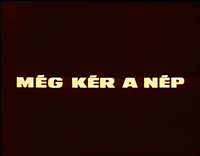
Még kér a nép
Hungary, 1971, colour, 84 mins
Current DVD availability makes it easy to trace Miklós Jancsó’s career from his second feature Cantata (Oldás és kötes, 1963) to his sixth Silence and Cry (Csend és kiáltás, 1967) inclusive. But then there’s a hiatus, with The Confrontation (Fényes szelek, 1968) and the Italian-made La Pacifista (1970) available in Hungarian-only and Italian-only editions respectively, and Winter Sirocco (Sirokkó, 1969) and Agnus Dei (Égi bárány, 1970) not released at all. The end result, as far as someone forced to make a four-year leap from Silence and Cry to Red Psalm is concerned, is the impression of a substantial stylistic and thematic shift in Jancsó’s cinema. Although he had already dehumanised his protagonists to the point of abstraction, he’s now mythologising them, an approach that began with The Confrontation and reached its apogee both here and in Electra My Love (Szerelmem Elektra, 1973).
Red Psalm (whose Hungarian title, sourced from a poem by the nationalist Sándor Petőfi, translates as ‘And The People Still Ask’) has no introduction or scene-setting, though it’s easy enough to date it to the 19th century from the combination of costumes (the film is set in the timeless Hungarian puszta, Jancsó’s favourite location) and explicitly Marxist rhetoric. In fact, it’s set in 1890, and concerns a group of farm labourers who have decided to go on strike. The leather-jacketed bailiff initially attempts to bribe them with grain, petulantly burning it when they refuse. Appalled by his cavalier attitude both to the fruits of their labour and their future well-being (without the grain they will starve), they kill him, and the army is summoned to suppress a potential revolt. But when a young soldier refuses to open fire on the workers, he is shot by his colleagues, only to be resurrected by a young woman’s kiss. Various other attempts are made to negotiate with the strikers, from the landowner himself (who spontaneously dies after stating his position) to a priest, whose church is burned down with him inside it. Finally, after delivering an ultimatum, the army massacres the strikers. A young female survivor picks up a gun and starts picking off the soldiers one by one…
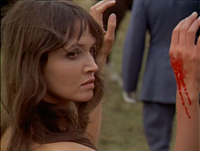
Reducing Red Psalm to its basic narrative outline, as I’ve just done, makes it sound like a crude piece of socialist agitprop, and its considerable musical content (its messages are as likely to be sung as declaimed) suggests affinities with the Marxist musicals of Grigori Alexandrov (Circus/Цирк, 1936) or Ivan Pyriev (Tractor Drivers/Трактористы, 1939; Cossacks of the Kuban River/Кубанские казаки, 1949). But those are altogether jollier affairs than Jancsó’s stark political parable, and far more straightforward in their construction and mise-en-scène. Once again, Jancsó is clearly fascinated by the mechanisms of power and oppression, both in theory and practice, and even when his film appears to be at its most deceptively bucolic, one can usually see evidence of a military presence in the background, and often a large-scale one.
Although Red Psalm unambiguously takes sides – something unusual for Jancsó – he never lets us forget that the revolution that the film advocates is perpetually under threat from the vested interests of the ruling classes (the capitalist landowners, the church, the military), who will not hesitate to resort to violence if their hegemony is called into question. And they’ll do it without a qualm, unlike the soul-searching strikers after they burn down a church in protest at the priest’s patronising sermon (he calls them his “misguided flock”). This leads to the despairing but logically inescapable conclusion that violent revolution is the only solution – though Jancsó sweetens the pill by staging the climactic confrontation in such a stylised manner (a young woman in a plain red shift mowing down swathes of soldiers despite being armed with a single pistol) that it’s more stirring than bleak.
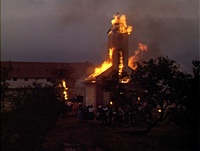
Although Jancsó’s signature is instantly recognisable (it’s hard to imagine anyone else even trying to make a film like this, much less succeeding), there are several marked changes between Red Psalm and his 1963-67 output. He has abandoned the wide screen for the squarish Academy frame of his first films, and is now shooting in colour. While individual shots are as lengthy as ever (just twenty-eight in total, most running several minutes), their staging is different – I don’t recall him ever using a zoom lens in his black and white films, but it’s constantly in evidence here. Previously, the deep-focus shots would ensure that the surrounding landscapes remained as sharp as the people in the foreground, but here the depth of field is constantly changing: whenever Jancsó fills the frame with just one or two individuals, the background becomes blurred and foreshortened. The effect is of cutting to a close-up, albeit here within the same shot.
The film’s formal virtuosity is often so astonishing (Jancsó won a richly deserved Best Director prize at the Cannes Film Festival) that it’s easy to appreciate the film without sympathising with or even processing its underlying message. The frequent zooming and foreshortening accentuates the impression, already suggested by The Red and the White ( Csillagosok, katonák, 1967), that Jancsó is merely filming an existing event that would have happened without the presence of the cameras – we know there’s a vast amount happening just outside any given frame as we’ve already seen it in an earlier part of the relevant shot.
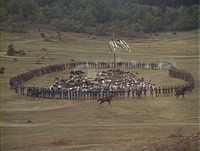
There are impressive individual set-pieces throughout, but perhaps most spectacular is the large-scale massacre towards the end, shot from a single camera position in the far distance, with soldiers and peasants singing and dancing together in apparent unison before the soldiers regroup into a circle around the peasants, trapping them in a human stockade (encircled by a number of men on horseback) before bringing out the rifles. There were apparently 1,500 people appearing on camera, and the choreographic logistics alone take the breath away. The unexpected background appearance of a steam locomotive pulling a train laden with hundreds of soldiers is equally startling (as no tracks have been visible up to then), but so too is the way that Jancsó will often move from distant observation to extreme close-up in the same shot, picking out details in a constantly swirling human panorama. János Kende’s ceaselessly circling camerawork, reputedly requiring more assistance than usual just to keep things in focus, is beyond praise.
While many of Jancsó’s previous films featured little or no music, Red Psalm is saturated with it, from the opening sequence in which the Marseillaise is sung with new lyrics that are more relevant to the situation at hand. Other songs range from traditional Hungarian folk tunes to Russian revolutionary ditties to, most surprisingly, ‘Charlie Is My Darling’ (in the more politicised American variant, whose protagonist is Johnny), all seamlessly sewn into the overall texture, singers, dancers and instrumentalists equally visible on screen. The men’s dances, their arms around each other’s shoulders, supplies a visual motif denoting brotherhood, solidarity and the importance of banding together, symbolically undermined towards the end when a guitarist stabs a singer in mid-delivery. There is no attempt at realism: a dead soldier is revived by a kiss, blood is initially shown but later replaced by symbolic red rosettes, and although three women (whom the critic Raymond Durgnat aptly called “the three graces”) strip naked and consort with hundreds of soldiers, there’s no hint of threat or violence: Jancsó seems far more interested in the contrast between their sun-kissed flesh and the pallid blue-grey of the soldier’s uniforms.

Red Psalm has inescapably dated: the early 1970s may have been the last time such overtly Marxist propaganda could be presented with a straight face outside east Asia, and it’s best viewed today as a historical parable on two levels, representing both the 1890s of its setting and the still flickering spirit of 1968 that clearly animated its creation. But, like Sergei Eisenstein’s not dissimilar Strike (Стачка, 1925) – Jancsó’s associative montages are no less intricate for being staged within the same shot – Red Psalm is such a formidable work of art on its own terms that it diffuses political criticism on those grounds alone. Even by Jancsó’s standards, it’s an extraordinary film, probably his most thoroughly thought-through achievement since The Round-Up (Szegénylegények, 1965), and certainly his most immediately intoxicating.
- Director: Miklós Jancsó
- Producer: József Bajusz
- Screenplay: Gyula Hernádi
- Photography: János Kende
- Production Design: Tamás Banovich
- Costume Design: Zsuzsa Vicze
- Editor: Zoltán Farkas
- Sound: György Pintér
- Music: Tamás Cseh
- Cast: József Madaras; Tibor Orbán; Tibor Molnár; Jácint Juhász; Gyöngyi Bürös; Andrea Drahota; Erzsi Cserhalmi; Márk Zala; Gyula Piróth; János Koltai; Gábor Kiss; György Cserhalmi; László Horváth; František Velecký; Betalan Solti; Lajos Balázsovits; Elemér Ragályi; András Bálint; István Bujtor; Péter Haumann; József Vándor; Tamás Szentjóby; György Pintér; István Szendrő; Lajos Fazekas; Mari Csomós; Ilona Gurnik; Éva Spányik; Tamás Cseh; Ágnes Lipták; Ferenc Sebő; Ferenc Pesovár; Ágnes Music; László Nagy; Lajos Farkas; Zsuzsa Fábri; Tünde Terényi; Péter Éri; Zoltán Nagy; Zsuzsa Ferdinándy; Géza Ferdinándy; Gáspár Ferdinándy; András Szigeti; Andrea Ajtony; András Ambrus; György Gonda; Frigyes Gödrös; Béla Halmos; Pál Hetényi; Levente Hídvégi; Pál Keresztes; Anna Koós; Erzsi Kopácsi; Miklós Kovács; István Kún; András Mészáros; László Pelsőczy; Tamás Pintér; György Reinitz; Azucena Rodriguez; Éva Szendrei; András Széll; István Szilárdy; Gyula Szombathy; Balázs Tardy; Sándor Vajó; Tamás Varga; Gyöngyvér Végh
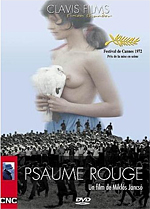
DVD Distribution: Clavis Films (France), PAL, no region code
Picture: Aside from reel change marks and very occasional spots, the source print is in almost immaculate condition, and the transfer is superb – crucially, the colours ring true, especially those all-important reds. Although it’s hard to tell from the constantly moving camera, the 1.33:1 aspect ratio appears to be correct.
Sound: Aside from mild background hiss (which is easy enough to ignore), the mono soundtrack is very acceptable and probably closely reflects the original materials.
Subtitles: As usual with this label’s Jancsó releases, optional French and English subtitles are provided. Plus points: most of the song lyrics are translated, which is more than usually essential in a film like this. Minus points: there are loads of typos (some rendering the lines borderline incomprehensible), they’re sometimes cut off at the sides, and on at least one occasion the French subtitle appears by mistake. Oddly, the DVD Beaver review claims (with supporting evidence) that the subtitles are white, but the oned on my copy are definitely bright yellow.
Extras: Comfortably Clavis’s most generous Jancsó package to date, this includes a (French-language) director’s biography and filmography, short excerpts from Clavis’ other Jancsó releases, and the complete ‘Hegyalja’ episode from the 1994 Message of Stones TV series – thankfully, a different one from that featured on Second Run’s discs.
Links
- Filmtörténet (in Hungarian, but with video clips)
- Internet Movie Database
- Raymond Durgnat’s essay on the film (by far the longest available online, and possibly anywhere).
- Reviews: Best Original Score (The Proprietor); Cinepassion (Fernando F. Croce); Dennis Grunes; Time Out (Verina Glaessner)
- Kinoeye’s excellent overview of Jancsó’s 1960s career briefly mentions Red Psalm.
- Clavis Films’ page about their DVD (includes video clip).
- Clavis DVD available from: Amazon.fr; Fnac, Alapage
Quite a shame this movie isn’t more popular internationally. I’ve seen it and thought it was VERY well done :)
Thank you for taking the time to write such a detailed description and analysis of this film. I just saw it at Facets Cinematheque, and it’s truly incredible. One hopes we’ll someday see a US DVD release.